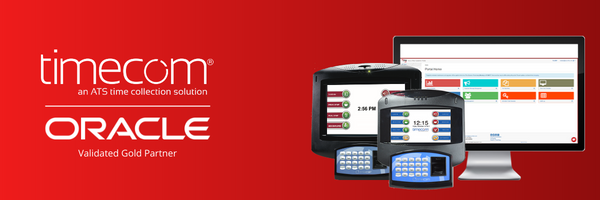Within the healthcare industry, employee time clocks are essential for streamlined operations and efficient workforce management. The time cards model might come to mind when you think of an employee time clock. While standalone mechanical and electrical time clocks offer value, they are error-prone and limited in their functionality. You can't combine them with advanced tools you use to manage a complicated workforce, such as Oracle for healthcare.
To optimize your Oracle system and its connection to your time tracking solution, you need a time clock with advanced features. These features will enhance accuracy, accountability, and efficiency.

Fully Automated and Integrated
Modern employee time clock systems are automated and integrated. The time clock should gather employee attendance information and send it to your Oracle system in near real-time. Automating the collection of the attendance records minimizes data errors, which lowers administrative costs.
Advanced time clock systems, such as ATS's Timecom, automate the collection of payroll data, including department and role. Many companies with large workforces need to allocate labor costs to specific departments. You can configure a Timecom time clock to allow personnel who work in multiple departments to specify the department when they clock in.
Integrating your time clock system with Oracle speeds up data delivery to departments that need it. A reliable integration ensures that all departments are working with the most current employee time and attendance data.
A fully integrated system also sends data from Oracle back to the time clock. Timecom is certified by Oracle and provides two-way data flow. Employees can view total hours worked and other information at the online time clock.
Smooth User Experience
Efficient clock-ins and outs are pivotal in the hectic healthcare environment where smooth shift changes are essential. Modern employee time clock systems use badges with barcodes or magnetic strips for employee identification. The time clock reader should process employees’ badges quickly, so employees don’t have to line up at shift change.
However, vulnerabilities may persist as employees can share badge, potentially leading to time theft. Biometric time clocks offer a robust alternative. A biometric time clock app authenticates employees through unique biological features like fingerprints or iris scans, effectively preventing fraudulent practices.
Pre-Configured Time Clocks
Pre-configured time clocks are factory-configured based on the customer’s specifications. ATS pre-configures every time clock to your company’s specifications before sending them out.
You can have ATS configure Timecom clocks to enforce meal and break rules according to the specific location they are in. This functionality helps large hospital systems improve their compliance with local labor laws.
In addition to selecting the department when clocking in, the time clock should be configurable so employees can select the role when clocking in too, if you require it. This feature makes sure labor costs are allocated correctly and employees are paid accurately for their roles.

ATS Time Clocks: Tracking Time for Healthcare
Accu-Time Systems' array of innovative solutions offers versatile options tailored to the demands of healthcare workforce management. The seamless integration between Oracle and ATS's PeoplePoint Plus and PeoplePoint Premium, ensures precision and efficiency when tracking employee time.
You can customize both time clocks, which have a variety of features, including configurable function keys and web services. The PeoplePoint time clocks have exceptional durability, lasting years longer than typical time clocks.
Our Maximus Severe Duty time clock has many of the same features as the PeoplePoint clocks and is designed to operate in harsher environments. For example, its exceptionally durable construction allows it to work unaffected by vibrations coming from large machinery. All these time clock solutions have a biometric option to protect your healthcare institution from fraud and overpaying for labor.
Investing in Accu-Time Systems' advanced terminals signifies a commitment to optimizing workforce management in the healthcare sector, ensuring accuracy, compliance, and operational excellence.
To find out more about the best employee time clock to integrate with your Oracle for healthcare system, download Accu-Time Systems’ free Time Clock White-paper. 





